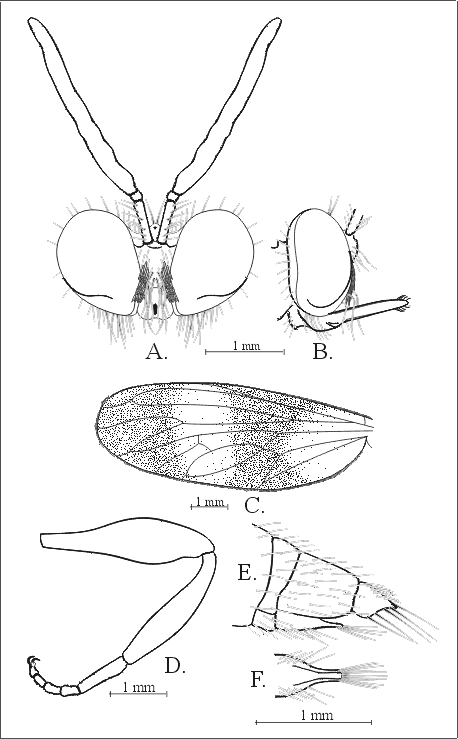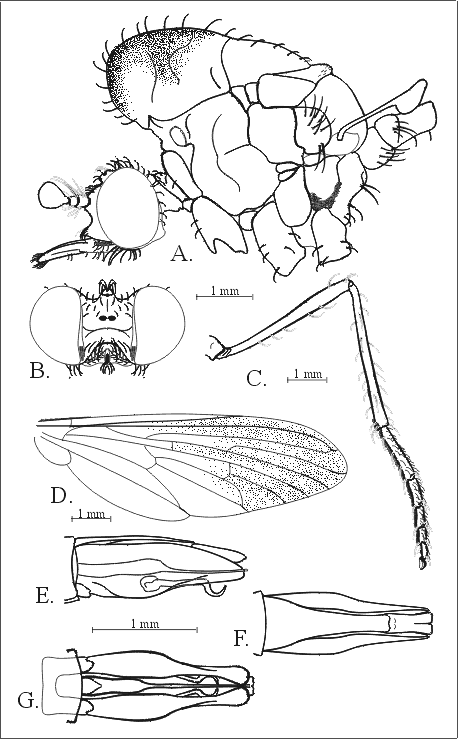
Fig. 1a-f: Ichneumolaphria schachti spec. nov., female - a: head in frontal view; - b: head in lateral view; - c: left wing; - d: hind leg in lateral view; - e: ovipositor in lateral view; - f: sternite 8 in ventral view; scale bars = 1 mm.
[Eine neue Ichneumolaphria-Art aus Brasilien und die Beschreibung des Männchens von Pseudorus dandrettae Carrera, 1949 (Diptera: Asilidae)]
by
[Published in: Studia Dipterologica 4(2): 457-462, Halle an der Saale]
Key words: Diptera, Asilidae, Ichneumolaphria, spec. nov., key, Pseudorus, Neotropical, Brazil
Stichwörter: Diptera, Asilidae, Ichneumolaphria, neue Art, Schlüssel, Pseudorus, Neotropis, Brasilien
Female
Head black; back of the head dark-brown pruinose, shining between ocellum and front edge of antennal tubercle, pale-brown beneath it. Face flat, except for the anntennal tubercle which is as high as the length of 2nd antennal segment (Fig. 1a). Black occipital setae restricted to the lower 2/3 of the back of the head; face with dark hairs below the antenna and pale hairs on lower half, with distinct scales present in two groups at lower sides, pale mystax composed of several long and weakish bristles (slightly longer than the combined length of antennal segment 1 + 2); post-genal beard white. Proboscis long and thin, laterally compressed, with white hairs at base and top. Palpi black with black and white hairs. Antenna black with brownish tomentum, except for tip of segment 3 which is pale tomentose; 3rd segment extremly elongate (Fig. 1a); ratio of segments: 1 to 0,2 to 4,8; black bristles on the first two segments only.
Thorax black, except for the reddish-brown tip of humeral callus, anepimeron (pteropleuron), mediotergite (metanotum), metepimeron (posterior metasternum), postalar wall and scutellum. Mesoscutum sparsely brown tomentose with short black hairs (as long as antennal segment 2), only 1 yellow notopleural and 2 brown postalar setae. Pleura pale brown tomentose; sides of pronotum and anepisternum (mesopleuron) with long yellowish hairs, proepimeron (prosternum) with whitish hairs; postnotal fan (metapleural tuft) long and yellow, arranged in 4 - 5 rows. Scutellum shining on disc, tomentose at sides; with short brownish hairs at sides, without scutellar setae.
Legs pale in colour; coxae black (hind coxa somewhat lighter), with white tomentum and hairs; trochanters mahogany-brown; all femora reddish-brown with darker tips; fore and mid tibiae reddish-brown, hind tibiae dark brown (except for base and tip); tarsal segments 3 - 5 dark brown. Clothing hairs yellow, except for black hairs on dorsal tip of mid femur, distal half of hind femur, hind tibia, last tarsal segments of fore and mid legs, and all tarsal segments of hind leg. Fore and mid legs with yellow bristles (except for the black bristles on tarsal segments 3 - 5), hind leg with black bristles (except for those at base of femur, which are yellow). Hind femur and tibia somewhat swollen (Fig. 1d).
Wings infuscated dark brown (by dense microtrichia), except for basal part and a central spot which are pale yellowish (Fig. 1c); costa with black hairs.
Abdomen rather slender like the thorax, tapering from tergite 5; without postmetaxoxal bridge; segments 1 - 4 reddish-brown, subsequent segments black. Clothing hairs short and predominantly yellow on the first three tergites, tergites 4 - 7 with black hairs on dorsal surface and white on sides; hairs on sternites the same, but longer. Fine bristles at the sides of the first tergite only, no discal setae. Sparse brownish tomentum as far as the 7th segment and of base of 8th sternite.
Ovipositor subcylindrical, conically pointed at the tip, with black bristles and yellow hairs; sternite 8 extended blade-like (Fig. 1e, 1f).
Body length: 8,5 mm; wings: 8,5 mm.
Male: unknown.
Derivatio nominis: The species is named after Wolfgang Schacht (Munich).
| 1 | Wing brownish tinged, basal part and a central spot pale yellowish (Fig. 1c). . . . . . . . . . schachti spec. nov. |
| - | Basal part of wing dark infuscated. . . . . . . . . . 2 |
| 2 | Infuscated wing with a central yellowish spot along the anterior border (the section from costal vein to discal cell). . . . . . . . . . zikani Carrera, 1951 |
| - | Basal half and tip brownish tinged, with a pale transverse spot behind the middle of wing. . . . . . . . . . fascipennis (Hermann, 1912) |

Fig. 1a-f: Ichneumolaphria schachti spec. nov., female - a: head in frontal view; - b: head in lateral view; - c: left wing; - d: hind leg in lateral view; - e: ovipositor in lateral view; - f: sternite 8 in ventral view; scale bars = 1 mm.
Material: Male Brazil, Santa Catarina, Nova Teutonia, 27°115'S 52°23'W, XI. 1977, leg. F. Plaumann; Eing.-Kat. Nr. 26/88; deposited in the Zoologische Staatssammlung Munich, Germany (ZSMC).
Male
Head shining mahogany-brown, only a narrow parafacial strip along edge of each eye with silvery pile (only visible in special lamp position) (Fig. 2b). Face moderately produced on the upper two-thirds, with a strong ventral, lip-like extension that is abrupt dorsally and obliquely truncate below (like other species of the genus), antennal tubercle as high as the length of the 1st antennal segment (Fig. 2a). All hairs and bristles yellow, except some that are black on the back of head and the bristly hairs of the occiput (which is visible in profile). Proboscis directed horizontally forwards and a little upwards, with pale hairs. Palpi mahogany-brown with pale hairs, long and slender, slightly shorter than length of antenna. Antennal segments 1 + 2 black with black hairs and bristles (ventrally and dorsally), 3rd segment disc-shaped (greatest width before tip), laterally flattened, bright orange with a minute terminal spine in a pit.
Thorax shining mahogany-brown, except for the anterior bulge of mesoscutum, which is shining darkbrown to black (Fig. 2a); tomentose areas are a short pale median stripe on mesoscutum (starting slightly before the transverse suture and not reaching scutellum) and an arched pale stripe on the metepisternum (both only visible in special lamp position). Profile as P. piceus (cf. Fig. 6(2) in Oldroyd, 1964); humerus strongly protuberant. Bristly black hairs on mesoscutum sparse, mainly along two narrow dorsocentral stripes (as long as the combined length of antennal segments 1 + 2); 1 notopleural, 1 supraalar and 2 postalar bristly hairs; hairs on pleura and pronotum yellow; postnotal fan rather sparse and yellow. Scutellum without tomentum or scutellar setae, with only a few short yellow and thin hairs. Postnotum exceptionally prominent, with a triangular pale tomentose stripe (only visible in special lamp position).
Legs slender, shining mahogany-brown, except for front tibia, hind femur and all tarsal segments, which are somewhat darker. Only coxae with pale yellowish hairs, and some black ones on hind coxa; sparse black bristles on femora and tibiae; tarsal segments with black bristles and bristly hairs; hind tibia not clavate (Fig. 2c); fore basitarsus little shorter than four other tarsomeres together.
Wings somewhat shining, hyaline in basal half, apical part yellowish-brown tomentose with microtrichia (Fig. 2d). Venation: only two submarginal cells; marginal, fourth posterior and anal cells closed and stalked; first posterior cell open; radial medial crossvein situated at basal third of discal cell.
Abdomen elongate, slightly narrowed at base; shining mahogany-brown with indistinct darker spots, without tomentum. Bare except for yellow hairs on sides of the 1st tergite, small black hairs on the hind margins of tergites 4 - 7, and small yellow hairs on each side of all tergites and sternites.
Hypopygium elongate, mahogany-brown, with black hairs and bristles (Fig. 2e); epandrium with the two halves completely fused and fused to the hypandrium via a narrow bridge at sides (Fig. 2f); hypandrium with a pronounced median concavity; basistyli elongate, wide basally; dististyli placed medially on the inner side of basistyli, their tips sickle-shaped; basal half of aedeagus large (Fig. 2g), sides of tip with 3 minute spines on each side.
Body length: 10,5 mm; wings: 9 mm.
Female: as in the description of Carrera (1949) and Oldroyd (1964).

Fig. 2a-g: Pseudorus dandrettae male - a: head and thorax in lateral view; - b: head in frontal view; - c: hind leg in lateral view; - d: right wing; - e: hypopygium in lateral view (including position of aedeagus and dististyli); - f: hypopygium in dorsal view; - g: hypopygium in ventral view; scale bars = 1 mm.
The paper was received on 02 January 1997.
Last saved Jan. 1998
© F. Geller-Grimm